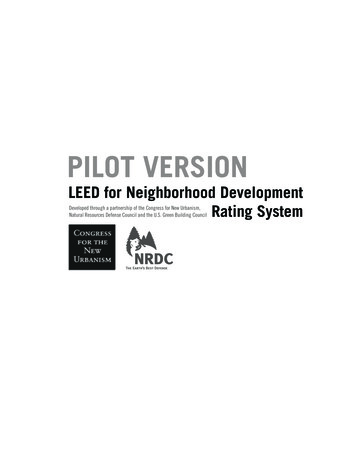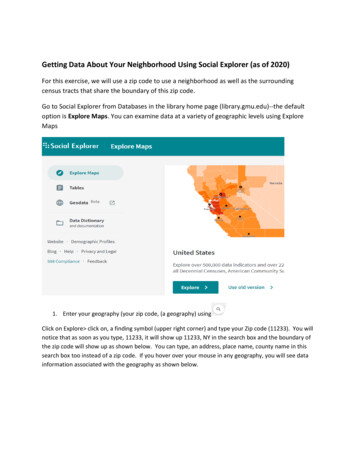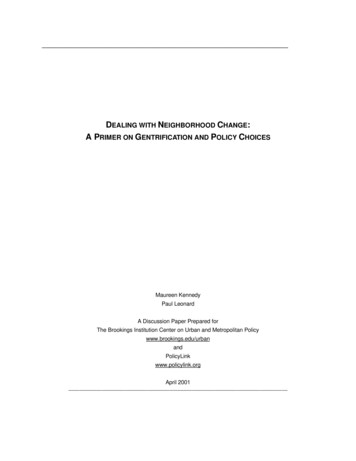
Transcription
DEALING WITH NEIGHBORHOOD CHANGE:A PRIMER ON GENTRIFICATION AND POLICY CHOICESMaureen KennedyPaul LeonardA Discussion Paper Prepared forThe Brookings Institution Center on Urban and Metropolitan cylink.orgApril 2001
THE BROOKINGS INSTITUTION CENTER ON URBAN AND METROPOLITAN POLICYSUMMARY OF RECENT PUBLICATIONS *THE DISCUSSION PAPER SERIES2001The Implications of Changing U.S. Demographics for Housing Choice and Location in CitiesSprawl Hits the Wall: Confronting the Realities of Metropolitan Los AngelesLost in the Balance: How State Policies Affect the Fiscal Health of CitiesGrowth at the Ballot Box: Electing the Shape of Communities in November 20002000Ten Steps to a High Tech Future: The New Economy in Metropolitan SeattleWho Should Run the Housing Voucher Program? A Reform Proposal (Working Paper)Do Highways Matter? Evidence and Policy Implications of Highways’ Influence onMetropolitan DevelopmentAdding It Up: Growth Trends and Policies in North CarolinaCautionary Notes for Competitive Cities (Working Paper)Business Location Decision-Making and the Cities: Bringing Companies Back(Working Paper)Community Reinvestment and Cities: a Literatures Review of CRA’s Impact and FutureMoving Beyond Sprawl: The Challenge for Metropolitan Atlanta1999Cities and Finance Jobs: The Effects of Financial Services Restructuring on the Location ofEmploymentTen Steps to a Living DowntownWelfare-to-Work Block Grants: Are They Working?Improving Regional Transportation Decisions: MPOs and CertificationA Region Divided: The State of Growth in Greater Washington, D.C.Washington Metropolitics: A Regional Agenda for Community and StabilityBeyond Social Security: The Local Aspects of an Aging AmericaThe Market Potential of Inner-City Neighborhoods: Filling the Information Gapi
Livability at the Ballot Box: State and Local Referenda on Parks, Conservation, and SmarterGrowth, Election Day 1998Towards a Targeted Homeownership Tax CreditTHE SURVEY SERIES2001High Tech Specialization: A Comparison of High Technology CentersVacant Land in Cities: An Urban Resource2000Office Sprawl: The Evolving Geography of BusinessUnfinished Business: Why Cities Matter to Welfare ReformFlexible Funding for Transit: Who Uses It?1999Children in Cities: Uncertain FuturesHousing Heats Up: Home Building Patterns in Metropolitan AreasWhere Are the Jobs?: Cities, Suburbs, and the Competition for EmploymentEds and Meds: Cities’ Hidden AssetsThe State of Welfare Caseloads in America’s Cities: 1999FORTHCOMINGThe Spatial Distribution of Housing-Related Tax Expenditures in the U.S.* Copies of these and other Urban Center publications are available on the web site, www.brook.edu/urban,or by calling the Urban Center at (202) 797-6139.ii
POLICYLINKSUMMARY OF RECENT PUBLICATIONS*2001Achieving Equity through Smart Growth: Perspectives from Philanthropy2000Briefing Book: Strategies and Examples of Community-Based Approaches to Equity andSmart Growth – A Working DocumentCommunities Gaining Access to Capital: Social Equity Criteria and ImplementationRecommendations for the Community Capital Investment Initiative (CCII)Communities Now!: A Newsletter Describing the Impact of the Community Reinvestment Actand the Fight to Save it in 2000Community Based Initiatives Promoting Regional Equity: Profiles of Innovative Programsfrom Across the CountryCommunity Involvement in the Federal Healthy Start ProgramFrom Promising Practices To Promising Futures: Job Training in Information Technology forDisadvantaged Adults1999Community Based Regionalism: California ConveningOpportunities for Smarter Growth: Social Equity and the Smart Growth MovementPerspectives on Regionalism: Opportunities for Community-Based Organizations toAdvance Equity – A Review of the Academic and Policy LiteratureThinkers and Resources for Promoting Equitable Development*Information about these publications, including the full text of many of them, is available on the PolicyLink website,www.policylink.org.*iii
ACKNOWLEDGEMENTSThe Brookings Institution Center on Urban and Metropolitan Policy would like to thank the SurdnaFoundation, Inc. and the Fannie Mae Foundation for their generous support of the Center and itswork on competitive cities. PolicyLink is grateful for the support it receives from the RockefellerFoundation, the Ford Foundation, the Annie E. Casey Foundation and the Open Society Institute.ABOUT THE AUTHORSMaureen Kennedy is a California-based policy consultant focused on housingand economic development issues, and high-leverage social change strategies. She served in theClinton Administration, first in the White House, then as Deputy Assistant Secretary for Policy at theDepartment of Housing and Urban Development, and finally as Administrator of the Rural HousingService. Paul Leonard is a policy consultant specializing in issues of housing, communitydevelopment and welfare reform, based in Berkeley, CA. He served as acting Assistant Secretary forPolicy Development and Research and Deputy Assistant Secretary for Policy Development at theU.S. Department of Housing and Urban Development. Comments on this paper can be sent directlyto the authors at MaureenKennedy@aol.com and paleonard@home.com.The views expressed in this discussion paper are those of the authors and are not necessarily those ofthe trustees, officers, or staff members of the Brookings Institution, nor of the board of directors ofPolicyLink.Copyright (c) 2001 The Brookings Institutioniv
ABSTRACTThis paper serves as a primer on how to view the complex issue of gentrification. It reviewsthe findings, analyses and frameworks developed during the gentrification wave of the ‘70s and ‘80s.The paper outlines the complex ways that current and “original” residents view gentrification—andclarifies that long-time neighbors can take very different positions on the gentrification issue.Additionally, the paper shows the wide range in the way gentrification pressures play out in threevery different cities and one multi-city region – Atlanta, Cleveland, Washington, D.C., and the SanFrancisco Bay Area – pointing out that gentrification is a much more urgent concern in some areasthan in others, where it hardly exists at all. Finally, the paper suggests policies and strategies thatcan be pursued to advance equitable development by optimizing the benefits of neighborhoodchange while minimizing or eliminating the downsides of such change.v
TABLE OF CONTENTSI.INTRODUCTION . 1II.THE GOAL OF REVITALIZATION: EQUITABLE DEVELOPMENT . 4III. GENTRIFICATION DYNAMICS:DEFINITION, SCALE, CAUSES AND CONSEQUENCES. 5A.B.C.HOW BIG A TREND IS GENTRIFICATION? . 7WHAT ARE THE CAUSES OF GENTRIFICATION? . 9CONSEQUENCES OF GENTRIFICATION . 14IV. THE POLITICAL DYNAMICS OF GENTRIFICATION . 25V.MAKING GENTRIFICATION W ORK FOR THE COMMUNITY, CITY AND REGION:10 STEPS TO A STRONGER COMMUNITY . 281. KNOWING THE CONTEXT. 292. ANTICIPATING THE PRESSURE. 303. GETTING ORGANIZED . 304. DEVELOPING A UNIFIED VISION AND IMPLEMENTATION PLAN. 315. IMPLEMENTING REGULATORY AND POLICY FIXES . 326. MAXIMIZING PUBLIC ASSETS FOR THE PUBLIC GOOD . 367. EDUCATING RESIDENTS ABOUT THEIR LEGAL RIGHTS ANDOTHER OPTIONS . 378. IMPROVING THE PUBLIC EDUCATION SYSTEM . 379. PREPARING GROUPS TO NEGOTIATE . 3810. CREATING FORUMS TO UNIFY THE GENTRIFYING COMMUNITY . 38VI. CONCLUSION . 40APPENDIX A: RESPONSES TO GENTRIFICATION — FOUR CASE STUDIES . 42A. SAN FRANCISCO BAY AREA . 42B. ATLANTA . 49C. WASHINGTON. 54D. CLEVELAND . 60APPENDIX B: ADDITIONAL RESOURCES. 65BIBILOGRAPHY . .66vi
PREFACEThe Brookings Institution Center on Urban and Metropolitan Policy’s mission is : (1) toconduct empirical research on market, demographic, and policy trends that affect cities andmetropolitan areas; (2) to produce new ideas about the challenges that emerge from these trends,in order to stimulate change; and (3) to create and nurture a broad network that will lead to sharedlearning and action.The Center has produced or collaborated on analyses of growth patterns in the Los Angeles,Atlanta, Phoenix and Washington, D.C. regions and in North Carolina. We have worked withpartners in Chicago, Cleveland, Philadelphia, Denver, Seattle, and elsewhere. This has made it clearto us that there is a wide range of economic, social, and growth conditions across, and within,different metropolitan areas. This paper’s description of gentrification pressures in the SanFrancisco Bay Area, Cleveland, Atlanta, and Washington, D.C. further reinforces the idea of thediversity of metropolitan environments and neighborhoods.However, there are some general trends we see, to varying degrees, across the country. Thegeneral trend in U.S. metropolitan areas is the steady movement of people and jobs toward themetropolitan fringe, and the concentration of poverty and distress in the central city and innersuburbs. We think that the movement of middle class people into central cities presents realopportunities—and challenges—for cities and neighborhoods, but it should not be mistaken for thestory of national development.Thus, the context for examining gentrification and its effects is one of diverse metropolitanareas and a general decentralization of economic and social life. Cities and metropolitan areas mustunderstand where they fit into this context. If gentrification is a concern, leaders need to implementpolicies that are fair and balanced. We think that the equitable development framework presented inthis paper is a promising source for these policies, which will have major implications forneighborhood planning, land use reform, and local tax policy. All of these implications need to beexplored and experimented with as equitable development moves from a concept to a tried-and-truemodel of development. If a city is not gentrifying, leaders must explore what they can do tojumpstart their economy and revitalize their neighborhoods. Without a strong fiscal base and healthymarkets, it is difficult for cities to help their residents thrive.We would like to thank Maureen Kennedy and Paul Leonard, for their thorough, balancedexamination of this issue, and the Fannie Mae, Surdna and Ford foundations for their support. Wealso appreciate the opportunity to work with PolicyLink, and look forward to working with them again.Bruce KatzDirectorThe Brookings Institution Center on Urban and Metropolitan Policyvii
PREFACEPolicyLink, a national nonprofit research, communications, capacity building and advocacyorganization, is dedicated to advancing policies to achieve economic and social equity based on thewisdom, voice and experience of local constituencies. Since our founding in 1999, few, if any,issues have galvanized these local constituencies as urgently as the phenomenon of gentrification.There is widespread concern that some neighborhood revitalization efforts are destabilizingcommunities that have strong traditional and cultural significance for low-income people of color.People living in areas of concentrated poverty hope that the renewed interest in their neighborhoodsportends an improvement in the quality of their lives. However, as they watch property values andrents rise, they worry that without knowledge, strategies and allies, the physical improvements thatthey have long sought will not be theirs to enjoy. As a result, there is a powerful demand for reliablefacts and useful policies that will enable community residents to embrace and fashion revitalizationand maintain their residency.The development patterns that lead to gentrification are shaped by a complex array ofprivate and public actions at the local, regional, state and federal levels. The patterns of growth anddecline, investment and disinvestment occurring throughout metropolitan regions reflect more thansimply economic opportunity and changing values. They also mirror failures to come to grips withissues of race and societal inequity. Avoiding or addressing the adverse consequences ofgentrification on low income people of color, therefore, will ultimately require policy solutions at alllevels that promote a genuine vision of regional fairness and inclusion that benefits all residents inthe region.Working with community-based practitioners, PolicyLink is creating an equitabledevelopment framework that can achieve that vision. Equitable development policies and practicescombine people-based and place-based strategies; create new tools and instruments to enable lowincome residents to gain an equity stake in the revitalization of their communities; and actively buildthe voice of residents so that they become agents of change in the development process. This reportis an important beginning in that it sorts out the causes and consequences of gentrification; explainsthe differences among cities’ patterns of development; and illustrates the economic, social andpolitical forces at work through several instructive case studies. The Brookings Institution Center onUrban and Metropolitan Policy and report authors Maureen Kennedy and Paul Leonard have beenexcellent partners, and we hope that this work adds value and raises the level of discussion on theseimportant issues.Angela Glover BlackwellPresidentPolicyLinkviii
ix
DEALING WITH NEIGHBORHOOD CHANGE:A PRIMER ON GENTRIFICATION AND POLICY CHOICESI. INTRODUCTIONGentrification, the process of neighborhood change that results in the replacement of lowerincome residents with higher income ones, has changed the character of hundreds of urbanneighborhoods in America over the last 50 years. Gentrification occurs in periodic waves: from thefederally sponsored urban renewal efforts in the ‘50s and ‘60s, to the so-called “back-to-the-city”movement of the late ‘70s and early 1980s. A number of U.S. cities, whose populations andeconomies appear to have bottomed out and are on the rebound, are experiencing another wave ofgentrification today.Clearly much in the urban landscape has changed since the late 1970s and early 1980s.The nation has experienced unprecedented economic prosperity, though income inequality haswidened and left the poor concentrated disproportionately in the urban core. Job growthpredominates in suburban areas rather than the cities’ cores. Cities now play a new role inmetropolitan economies, as the hub of information services, arts and entertainment, rather than asindustrial centers. Metropolitan areas have become ever more sprawling, sparking efforts to createmore sustainable development patterns in many metropolitan regions. And a new corps of mayorshas made attracting middle- and upper-income residents back to their cities a leading priority, torevitalize the tax base of their communities, the viability of their neighborhoods and the vibrancy oftheir downtowns.If not an explicit intention of cities’ redevelopment efforts, gentrification can be a byproduct,particularly in cities with little vacant land or few unoccupied buildings. For all the benefits it canbring, gentrification can impose great financial and social costs on the very families and businessowners who are least able to afford them. If development is to be equitable, if revitalization is tohave the essential support of those living in neighborhoods targeted for assistance, if the outcomesof these investments are to benefit more than those moving into the city, decisionmakers in thepublic and private sectors must anticipate these potentially harmful effects and take effective andtimely steps to mitigate them now, and into the future.A number of cities now experience gentrification in its many stages and intensities.However, it is important to point out that gentrification is not occurring across the country. Rather, ittends to happen in cities with tight housing markets and in a select number of neighborhoods. Manycities are still starved for new residents and revenues. The movement of new middle-class residentsinto U.S. cities is a small counter-trend; the dominant trend, by far, is movement away from centralcities and towards the suburban periphery. And, as this paper points out, where gentrification is anissue, it plays out differently in different cities.In the supercharged economy of the San Francisco Bay Area, gentrification createsnoticeable changes in neighborhood character in a matter of months. Rapid gentrification is1
occurring in some neighborhoods of Boston, Seattle, Chicago and Portland. Less rapid, butsignificant, levels of gentrification are occurring in Atlanta, Washington, D.C. and Denver. Othercities like Cleveland and Detroit are attracting some higher income residents into their cities andexperiencing modest levels of community revitalization, though they have not yet begun toexperience displacement, and therefore do not meet the definition of gentrification set forth in thispaper.While gentrification’s scale and pace may vary across the country, it is re-emerging for threebasic reasons. First, the nation’s strong economy creates great demand for labor and housing at theregional level, and in some cases this makes the housing in central cities and some inner suburbsnewly attractive to more higher income newcomers. Second, the federal government, states, citiesand non-profit organizations increasingly have the motivation, the resources and the specific policylevers and the overall strategies to direct revitalization efforts in targeted parts of central cities.Under some circumstances, these revitalization efforts can lead to gentrification. Third, in responseto the increased concentration of poverty in the urban core of our nation’s cities, public officials seekto reduce these concentrations by attracting higher income families into high-poverty neighborhoodsor by helping some poor residents to move to other portions of the metropolis where poverty is lessconcentrated. Either way, these place-based and people-based strategies can result ingentrification.The issue of gentrification has historically included a strong racial component—lower incomeAfrican American residents are replaced by higher income white residents. In fact, in most (but notall) gentrifying neighborhoods examined in the case studies, minority households (African Americanas well as Latino) have predominated in recent decades, and some argue that this residentialsegregation occurs with the tacit support of public and private sector institutions and traditions. As aresult, an influx of higher income households inevitably will put pressure primarily on historicallyminority communities.Based on our interviews in the four case study cities included in this paper, however, thestory gets more complex. The case studies suggest that higher income newcomers are raciallyvaried. They include white households in all cases, but can also include large proportions of Asianhouseholds (for instance, in the case of Bayview/Hunters Point in the San Francisco Bay area), andof African American households (for instance, in Atlanta, Washington, D.C. and Cleveland). While,gentrification’s adverse effects may fall predominantly on minority households, and as a result areimportant to resolve equitably, those moving into these neighborhoods may be minoritiesthemselves.In cities hit by gentrification pressures, residents, city officials and other interests frequentlydescend into rhetoric and factional fighting. This often occurs because different parties definegentrification differently, see different parts of the issue, or otherwise talk past each other.Moreover, the political focus is often on gentrification’s character and consequences without linkingthese more pragmatically to its “end game,” its causes and solutions. Our goal in this paper is tohelp all stakeholders—policymakers, neighborhood residents and community groups, business2
owners, and developers—better understand the dynamics of gentrification and address itproductively. In this paper, we will:1. provide a clear definition of gentrification;2. lay out the causes and the consequences of gentrification, both good and bad;3. attempt to clarify the perspectives of various stakeholders with regard to gentrification;and finally,4. offer some practical strategies to address gentrification in the context of equitabledevelopment.The methodology for this paper is multifaceted. Our work is grounded by four case studies inwhich we examine recent gentrification dynamics in both hot economies and those that havemoderate growth rates (see Appendix A). The descriptions of Atlanta, the San Francisco Bay Area,Cleveland and Washington, D.C. add depth and perspective to our work, and demonstrate howdifferently those living, working, rehabilitating and making policy in these cities and regions view thegentrification issue. In addition, we reviewed the existing literature on the topic and interviewedacademics, community activists, developers and others who are familiar with development dynamicsat the national level and in a number of additional cities across the country. Insights from these arewoven through the paper.This paper does not provide a “silver bullet” to resolve the negative effects of gentrification.Gentrification is driven by an imbalance in housing supply and demand. The imbalance leads tomany positive effects described in the paper, but also affordability problems, displacement, andunanticipated changes in the character of a neighborhood. The tools are available; many of themost effective strategies addressing these adverse effects of gentrification are already in place insome metropolitan areas. Often these tools were developed in other contexts, but can be put toeffective use in addressing gentrification (see Appendix B.)Rather than fine-tuning the tools, the more fundamental current challenges areorganizational: how to anticipate gentrification pressures at a point when the process can still beaffected, and to build the political capital needed to implement or expand the strategies in theneighborhoods undergoing gentrification.This paper does not conclude that gentrification is simply either good or bad. Rather, weconclude that if residents, developers, officials and interest groups spent more time developingstrategies to avert or address the adverse consequences of gentrification, and less time opposing orsupporting the market-driven process itself, they could increase the chances of building strong,economically diverse communities in our cities. Therefore, before outlining the findings and insightsfrom this research, we frame gentrification within the context of equitable development.3
II. THE GOAL OF REVITALIZATION: EQUITABLE DEVELOPMENTThe process of gentrification is set in the context of the politically charged urbandevelopment process, and is best understood in that context. The market and the non-profit andpublic sectors work with each other and people and neighborhoods of urban America to produceeconomic and community growth, change, and development. As we will describe in greater detailbelow, sometimes these private-, public- and non-profit sector actions combine and result in theprocess of gentrification, producing some positive outcomes, some negative outcomes, and manyoutcomes that are positive for some and negative for others. Against what standard should wemeasure this process, its causes, consequences and prescriptions?We argue that city officials, developers, policymakers, advocates, business owners andresidents should support the goal of “equitable development.” We define equitable development asthe creation and maintenance of economically and socially diverse communities that are stable overthe long term, through means that generate a minimum of transition costs that fall unfairly on lower1income residents. While public and non-profit officials may easily support such an idea, thebusiness community should support it as well. Without equitable development, the long-termprospects of a neighborhood, or the metropolitan area in which it is set, can dim. Equitabledevelopment is something that should be planned for and facilitated whether gentrification pressuresexist or not.2We leave it to others to further flesh out the concept of equitable development. However,we believe it can form the framework for evaluating whether an aspect of the gentrification process is“good” or “bad,” for debating whether it warrants hearty support or intervention, and for deciding thenext steps to take in optimizing the positive aspects of gentrification and minimizing or eliminating itsdownsides. For example, gentrification, by definition, creates a greater income mix and can offergreater economic opportunity to those that need it, both of which are consistent with equitabledevelopment. At the same time, the displacement that is part of gentrification can pose very largefinancial and social costs on those it affects. While the government and private sector cannot beexpected to reimburse original residents and businesses for all financial and social costs they bearas a result of gentrification, we should try to ensure that these costs of community change do not fallinappropriately hard on those least able to bear them.With equitable development the goal, and gentrification a process that spurs or impedes thatgoal, we now turn to analyzing gentrification dynamics in greater detail.1It is increasingly clear that concentrated poverty and segregated neighborhoods are bad for children, bad forthe viability of their communities, bad for the economic health of cities, and bad for surrounding suburbaneconomies. Therefore, the definition includes social and economic diversity. We discuss the research on thisissue later in the paper. In addition, a classic “market failure” warranting public intervention occurs whenmarket forces generate inequitable effects, for instance, for poor people. As a result, the definition includes acaveat regarding transition costs.2PolicyLink has produced several documents summarizing the literature and thinking of leading scholars andpractitioners on the concept of equitable development, especially as it applies to urban areas in the regionalcontext. See the bibliography entries under PolicyLink.4
III. GENTRIFICATION DYNAMICS:DEFINITION, SCALE, CAUSES AND CONSEQUENCESThe term “gentrification” is both imprecise and quite politically charged. In both thesubstantial academic literature on the subject and in the popular discourse, gentrification has had a3number of contrasting definitions. Some studies frame gentrification within the decades-longprocess of disinvestment and re-investment in a particular neighborhood, suggesting that publicpolicies and the owners of capital conspire, and enable higher income people to reap substantial4profits from gentrification. Others use the term interchangeably with urban revitalization, to describeany commercial or residential improvements in urban neighborhoods. Others consider gentrificationto more narrowly refer to the physical upgrading of low-income neighborhoods. Others havefocused primarily on the economic actions of newcomers, namely the renovation and upgrading ofthe housing stock. In contrast to these property-focused visions of the gentrification process, othersdescribe gentrification as the class and racial tensions and dislocation—the socioeconomic orpeople-based effects—that frequently accompany the arrival of new residents into a neighborhood.With so many notions of the term, it is important to specify the definition we apply togentrification. In this paper we define gentrification as the process by which higher incomehouseholds displace lower income residents of a neighborhood, changing the essential characterand flavor of that neighborhood. Often, though not always, gentrification has a very clear racialcomponent, as higher income white households replace lower income minority households,sometimes in the very same neighborhoods that experienced “white flight” and traumatic urban5renewal in the ‘50s and ‘60s.It is worth noting three key features of our definition. First, gentrification requires thedisplacement of lower income residents from their neighborhoods. We are most concerned aboutinvoluntary displacement, that is, the displacement of those “original” residents who would prefer tostay in their neighborhood, but because of non-just-cause evictions, rapidly rising rents or increasesin their property tax bills, cannot afford to do so. In addition to families that are directly displacedfrom changes in their neighborhood, researchers identify a form of exclusionary displacement, where6changes in the neighborhood prevent future lower income households from moving i
Additionally, the paper shows the wide range in the way gentrification pressures play out in three very different cities and one multi-city region - Atlanta, Cleveland, Washington, D.C., and the San

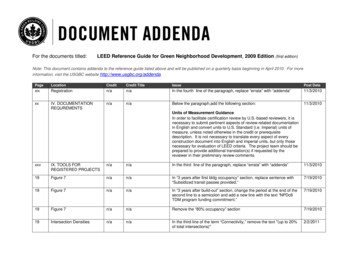
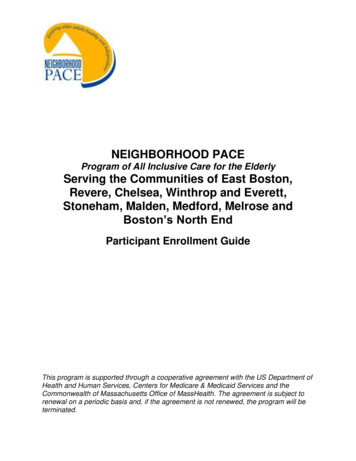


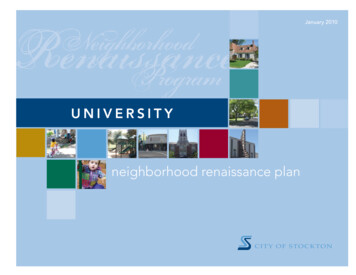
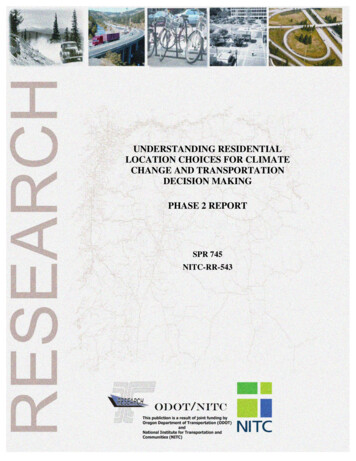
![Change Management Process For [Project Name] - West Virginia](/img/32/change-20management-20process-2003-2022-202012.jpg)
